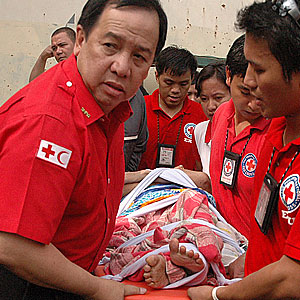When disasters hit, the matter of personal preparedness is one thing. But to know that, in moments of great distress and even confusion, there are people you could reach out to—that spells a lifeline. In that crucial divide between being besieged by a natural disaster and succumbing to its devastating, sometimes fatal effects, lies the expertise of a select group of men and women.
But while it may be extraordinary that a good number of these people are actually volunteers, and that they will always be there in times of great need, it also begs the question: how prepared are these people to actually come through for us when disasters hit?
If we learned anything from the recent super typhoons that hit the country in a span of a week in September 2009—first was Ondoy (international name: Ketsana), followed shortly by Pepeng (international name: Parma)—that is, when it comes to nature’s fury, everything can turn on its head in a moment’s notice. When Ondoy struck, what began as an initial common discomfort brought about by heavy rains and minor flooding soon turned worse. Areas that don’t normally flood quickly had rising waters, and in the same instance, news reports on TV were beginning to paint a picture of a national capital besieged, whose outlying towns were becoming virtual water worlds.
Former Senator Richard Gordon, also chairman of the Philippine National Red Cross (PNRC), recalls the day Ondoy came upon us. “It was difficult because we were marooned.” Stuck at the Fort Bonifacio area in Taguig, he shares, “I conducted the operations from there… [with] my cellphone. Suddenly it was just a barrage of calls.” No sooner than it was evident, Gordon stirred his people into action.
“Fortunately enough, we [Red Cross] were organized. And so we were able to use our rubber boats—I have bought more than 60 rubber boats, as well as rescue trucks. Then I mobilized Subic and Olongapo. And then the other Red Cross societies — they also helped out at the chapters. So we were able to move and help. But at that point in time, it’s just like scratching only the surface because ang laki-laki [ng sakop]… it was a mess, and this country was caught flat-footed,” Gordon says matter-of-factly.
This contention was not without merit. “Unang-una, the policemen didn’t show up to conduct traffic; uwian ang lahat,” Gordon relates. “In other countries—or at least in Subic or in Olongapo—wala kaming ganyan. Lahat ng police ko nakalabas. Lahat ng bumbero nakahanda. May mga tao na…”
There is no way to say now how matters could have turned out had Gordon been successful in his bid for the presidency in the last May 2010 elections. But now proudly an “ordinary citizen,” Gordon is not so ordinary given his lack of qualms about serving. Of his upbringing, he states, “My mother and my father were always prepared.” He even recalls incidents in Olongapo when it would flood or when there were fires. “My mother will come out and cook food for the poor people. Para sa mga natutulog sa bahay namin… mga naiwan na mga ampon. So we’ve been a family for others.”
Looking outside his family, Gordon’s work ethic is inspired by another thing—the U.S. Navy who formerly used Subic as its base was right beside Olongapo. “’Yung U.S. Navy, makikita mo talagang handa sila palagi. May gamit sila. So sabi ko ‘pag ako ang nanungkulan, meron gamit ang tao dapat. Kailangan, importante ‘yun. How can you expect them to fight a fire kung wala silang gamit?” he explains. As such, having become the PNRC chairman, he went about the serious business of equipping PNRC. “Yes, I have fire trucks here. I have (12) fire trucks dito sa Red Cross.”
Worse Fates and Hard Lessons
Sometimes you would think that a country beset with natural disasters would or should already be wise enough to implement appropriate preparations to prevent the calamities and their severe impact on us. However, it seems baffling that, despite only having two major seasons to contend with, and knowing for years how massive rainfall would likely cause disastrous flooding, there doesn’t really seem to be any concrete contingency measures put in place by the changing hands in the government. While each one of these government authorities would profess “we want to serve our countrymen” every time they would run for office, it’s infuriating that the major impact of Ondoy and Pepeng seem to have caught us still by surprise.
It’s not as if we haven’t experienced storms before. Would it be such a burden to think that any one of these weather disturbances brewing outside our country could actually turn out to be a super typhoon once it makes landfall? The fact that we need Ondoy and Pepeng as another reminder of how we need to pull ourselves together and be better prepared for such adversities is just unbelievable–when truth is, we have seen it all before. Just in the ‘90s, in fact, we had seen some of the worse typhoons hit the country: Loleng in October 1998, with winds of 250 kph, 303 deaths and P6.787 billion in damages; Rosing in late 1995, with 260 kph winds, 936 deaths and P10.83 billion in damages; Uring in 1991, 95 kph winds, estimated deaths from 5,000 to 8,000 people, and P1.04 billion in damages; and those are just a few.
An article by Ishaan Thanoor entitled “The Manila Floods: Why Wasn’t the City Prepared?,” which appeared on Time Magazine (also published on Time.com) in September 2009, states that,“…many in the country are pointing fingers at its politicians for failing to predict the scale of the disaster or lessen the damage it caused. Manila, they say, was always bound to face such catastrophe, and more should have been done to help its millions of residents prepare.”
Thanoor’s article also mentions the study done by the Economy and Environment Program for Southeast Asia (EEPSA), a research group based in Singapore, which had ranked metropolitan Manila “as one of the provinces in Southeast Asia most vulnerable to flooding. The capital region is perched on a marshy isthmus that is crisscrossed with streams and rivers. An ever-growing population — Manila is now a sprawling mega-city of some 12 million people, larger still when factoring in the day-worker population — and the lack of infrastructure to accommodate it left swaths of the city exposed.”
Metro Manila wasn’t the only area affected, for sure—on September 26, a state of calamity was declared not only in Metro Manila, but also in 25 provinces hit by the typhoon. Whereas not every rainy season would bring problems of catastrophic proportions, Gordon laments, “Sometimes we tend to take it for granted nga e. You would think we’re very resilient, but in fact, the damage causes a cycle of disaster and poverty that never ends. ‘Pag bagyo [maraming] nasisira, mababaha… Dapat hindi na sila nagpapatira sa low-lying areas, dapat ‘yung reforestation inaasikaso. Dapat ‘yung mga nakatira, hindi masyadong congested… You can expect pagka ganyan, mangyayari ‘yan.”
As examples, Gordon adds, “Alam mong magla-landslide na, dapat ‘yung mga tao alam nila na they are in a dangerous area and they should move out from there. If you don’t, you’re gonna have a disaster. Earthquake—nandun din ako. Wala ring gamit ang gobyerno nun nung ‘90s.” For help, he turned to the U.S. military and to his rescue team in Olongapo, and they were partially helped by the Philippine military.
For Gordon, volcanic eruptions and floods are always the hardest to deal with. He recalls rescue operations in Cabanatuan and Baguio, “Na-mobilize naman ang human resources right away to help that community. “Nung lumakad kami pati bareta (steel bars) binigay ng mga hardware stores; pati ‘yung mga gloves; pati acetylene torches, nagbigay sila. Kumpleto. Sa amin dumaan. ‘Yung pagkain… nakahanda kami. Tapos, Pinatubo! Sa ‘min pumutok ‘yon. Sa tabi ng probinsiya namin. So we were able to get out. Ako in-evacuate ko ka’gad. ‘Baba kayo diyan.’ Tinanong ko lang ‘yung Philvocs, ‘Kailangan ba ng evacuation?’ ‘Kailangan sir.’ Ako, ‘pag sinabing evacuate, evacuate ko. Pero mahirap… lahat pareho naman, e,” he admits. “Basta pumapatay… kahit landslide. Nakaranas na ako n’yan. Marami na rin tayong na-rescue d’yan.”
Indeed, the biggest detriment to responding to disasters, or even preparing for one and implementing the measures, could be one thing: “Political will,” Gordon stresses. “At saka ‘yung ‘pag natapos na ang bagyo, relax na naman.”
The Way of the (Red) Cross
On the day Ondoy hit, Gordon’s phone just went crazy. “People were calling me to send people to their areas. Somebody put my cellphone [number] on ANC,” he remembers. But perhaps it was just as well, because many people truly were desperate, considering the horrifying circumstances then—from impassable roads to people stuck away from home or even in their villages, waiting for rescue atop their roofs for hours with hardly any food to eat.
In dealing with rescues and responses, Gordon points out, “You have to have human resources (manpower) and logistics. Kung wala ka nun, mahihirapan ka.” He also adds, “Red Cross is very flexible. You can deploy our assets to other places. So I asked Balikatan to help out again, and they did. And we all went together. And we went to … my people all went to Pangasinan, San Fabian, to Dagupan. Naghati sila ng SBMA and Red Cross team at saka ‘yung Olongapo team. Kumpleto sila.”
Although, through Gordon, PNRC would only borrow helicopters for rescue operations, nevertheless, it has other areas covered. Apart from the 60 rubber boats, PNRC has about 80 ambulances and four rescue trucks, among others. More importantly, the staff undergoes regular training for CPR and first aid; some even undergo advanced training. The local chapters also conduct fire drills. In reference to the operations center in Port Area, Manila, Gordon points out, “Ito lang siguro ang building sa buong Pilipinas na may defibrillator machine on the walls.”
Gordon also reiterates that they have numerous rescue volunteers and even nurses. And because he also joins the rescues himself whenever he can, he plans of putting up a Red Cross headquarters in Taguig or Makati, “Para mas safe kung may earthquake… dahil dito (at the Port Area, which is by the sea), baka lumubog ito eh.”
When disaster strikes, Gordon is not above asking for help–but even he knows when to toe the line. Of the military, for instance, he says, “Sumusunod naman sila. Kaya lang siyempre, kung may ibang issue sila, hindi ako nakikigulo. I try to stay out of the way. Basta I’ll do what I can. Anyway, it’s too big e. Hindi naman kailangan isa lang ang hahawak niyan.” Indeed, relief and rescue is not a place for any turf war.
Meanwhile, Gordon’s work with Red Cross is never-ending: “I don’t complain. I just do what I have to do.” “I don’t criticize the military. Wala nga silang gamit dun e. So, nasan na sila ngayon? At least tayo, nakikita nila. More and more, matututo tayo diyan.”
And for everyone’s sake, this lesson must be learned fast… not just by the government or the people who conduct the rescue operations, but by each one of us. Being prepared for disasters and its effects is a matter of life and death. Besides, the dead can’t rescue the living.






